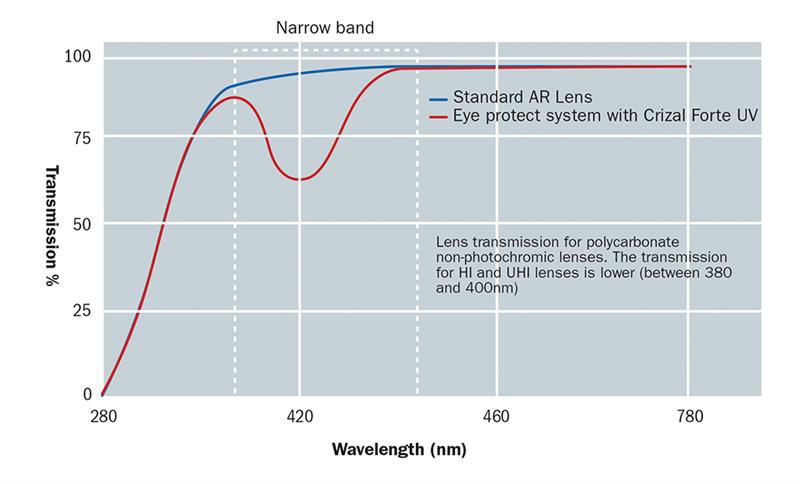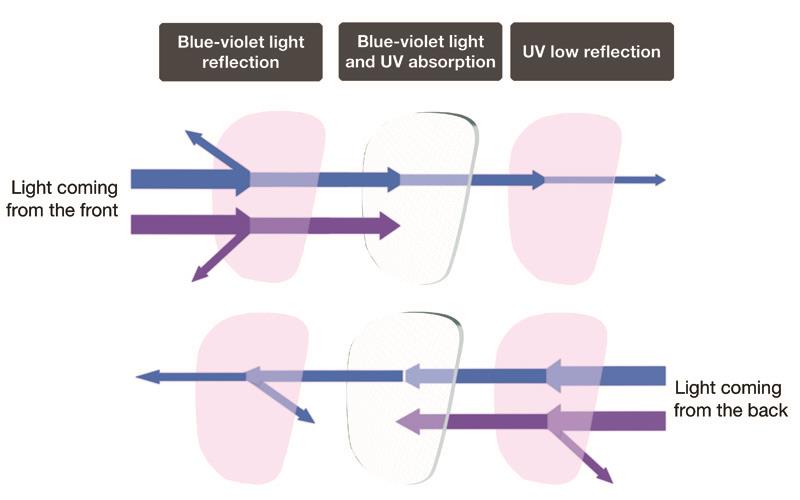Eye Protect System is the first embedded protection against harmful light1 in an aesthetically clear lens, offering eye care professionals the opportunity to dispense spectacle lenses which deliver protection against both UV and blue/violet visible light.
Why should we protect our eyes?
Harmful light is everywhere, mostly outdoors but also, albeit it at lower levels, indoors. The major source of light is of course the sun, emitting harmful ultraviolet (UV) and blue-violet light as well as the beneficial blue-turquoise (upon which we rely for maintenance of our diurnal metabolic body clock).
This exposure is increasing with the growth in the use of new artificial low energy lighting (LED is predicted to account for 70% of all lighting sources by 20201), and together these natural and artificial sources have greatly increased patients’ daily exposure to harmful light, and their eyes more vulnerable to the potential risk of cumulative tissue damage, both external or anterior and, depending on the clarity of the crystalline lens, retinal and macular.
Developing the Eye Protect System
Over recent years, Essilor research teams have been working alongside the Paris Vision Institute, studying light induced eye damage to improve the protection that spectacle lenses can deliver to the wearer. A better understanding of the biology behind ocular tissue damage is essential for developing refined solutions for adequately protecting our eyes.
The toxic nature of UV on ocular surface tissues and the skin which surrounds the eyes has been known for some time and it is therefore essential to provide wearers with protection against harmful light.
Three advantages
The Eye Protect System employs a unique absorption process offering three main benefits;
1: UV protection
Complimentary technologies will;
- Efficiently absorb UV trying to transmit through the lens front surface across all materials (except Orma 1.5).
- As the Eye Protect System lenses are combined with Crizal UV, they offer the wearer protection from back surface UV reflections.
This combination delivers light protection equivalent to ESPF10 and above.
2: Blue-violet protection (see figure 1)

Figure 1: Eye Protection System transmission curve
Until now, protection from the shorter visible wavelengths has been achieved through actively reflecting certain portions of the visible light. Crizal Prevencia, for example, uses this technique in a unique way by selectively filtering out the harmful blue-violet light while allowing the ‘good’ blue-turquoise light to be transmitted to a wearer’s eye.
In recent times a different approach was tested by Essilor research teams, whereby molecules were added within the lens material to actively absorb the relevant wavelengths. For reducing transmission of selected wavelengths, this technique has proven to be a success. As a benchmark, it was essential to ensure that the protection for wearers was at least at the same level as that offered by Crizal Prevencia.
This research eventually resulted in the development of the Smart Blue Filter, which ensures that Eye Protect System lenses filter out 20% of blue-violet visible light, resulting in a predicted 25% (+/- 5%) reduction in retinal cell death when compared with a lens with no filter. This may be evaluated by in vitro tests directly upon retinal pigment epithelium cells or by mathematical modelling.
For Eye Protect System lenses with Crizal Forte UV, there was a 25% decrease in light-induced retinal cell death versus no filter. For standard lenses (Orma 1.5 or Airwear 1.59 with Crizal Forte UV), there was an approximately 7% decrease (mathematically modelled).
3: No aesthetic compromise
For the first time our research teams have cracked the cosmetic conundrum by achieving UV and blue-violet light protection in an aesthetically clear lens (figure 2 - see above).
Any absorber within the lens substance filtering blue-violet light attributes a natural yellow colour to the lens which some wearers may find unappealing. To counteract this, two colour neutralising molecules were added to the smart blue filter.
Trialling the new lenses
To assess the effectiveness of the absorbers neutralising molecules, sensory analysis of the new lens was performed by skilled analysts who evaluated four parameters;
- Lens appearance.
- Skin appearance of wearer.
- Lens transparency.
- Colour perception when viewing through the lens.
Each of the four parameters consistently rated higher than without the absorbers. It is, therefore, fair to say that Eye Protect System lenses carry neither any residual tint nor blue reflection (figure 2). Wearer testing followed, and as an example, after a two-month wearer test, 100% of wearers were satisfied with the product.2
Eye Protect System with Crizal Prevencia
For added protection, Crizal Prevencia powered by Eye Protect System offers much more. When Crizal Prevencia is combined with Eye Protect System lenses, it gives far greater protection as the lenses are now delivering protection from two surfaces (see figure 3);
- Front surface – UV and blue/violet protection.
- Back Surface – minimised UV reflection into wearer’s eyes.
This combination offers maximised blue-violet light protection of, on average, 30%, which is predicted to reduce retinal cell apoptosis by 35%.

Figure 3: Eye Protect System combined with Crizal Prevencia offers protection at both surfaces of the lens
Summary
Eye Protect System lenses deliver an essential level of protection
- UV protection measured by E-SPF index. The E-SPF index depends on the lens material itself and the coating. E-SPF is a global index rating the overall UV protection of a lens. E-SPF was developed by Essilor International and endorsed by third party experts. It relates to lens performance only, and excludes direct eye exposure that is dependent upon external factors (such as wearer’s morphology, frame shape and position of wear).
- Up to three times more protection against visible blue/violet than standard prescription lenses.
- Aesthetically clear lens.
Product availability
From July 4, the Eye Protect System innovation is launched exclusively across the Varilux S series and Varilux E series range, and is available with Crizal UV.
Andy Hepworth is professional relations manager and Aude Bouillet is products and services manager at Essilor.
References
1 McKinsey & Company. Lighting the way – Perspectives on the global lighting market. 2nd edition report. Aug 2012
2 Eurosyn Acceptance Wearers Test (n=57 lens wearers wearing previously lenses with Crizal coating that have been equipped with Eye Protect System lenses with Crizal Forte UV coating (same index and Rx) / results after one month) – France – 2016.
